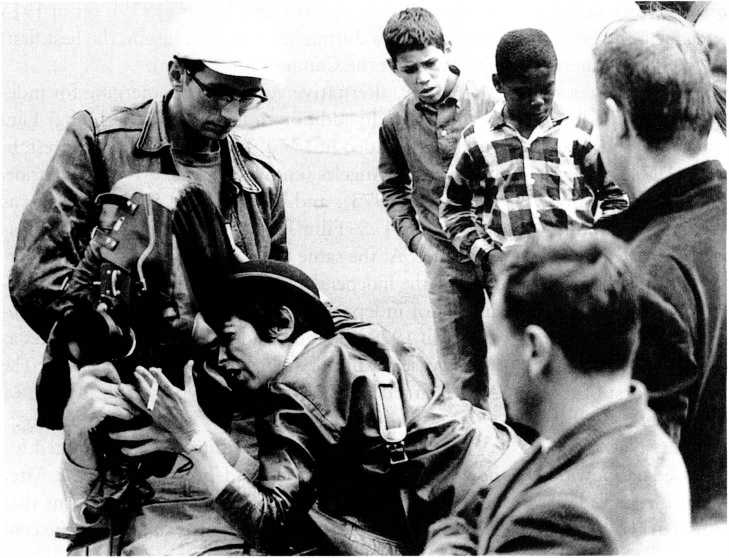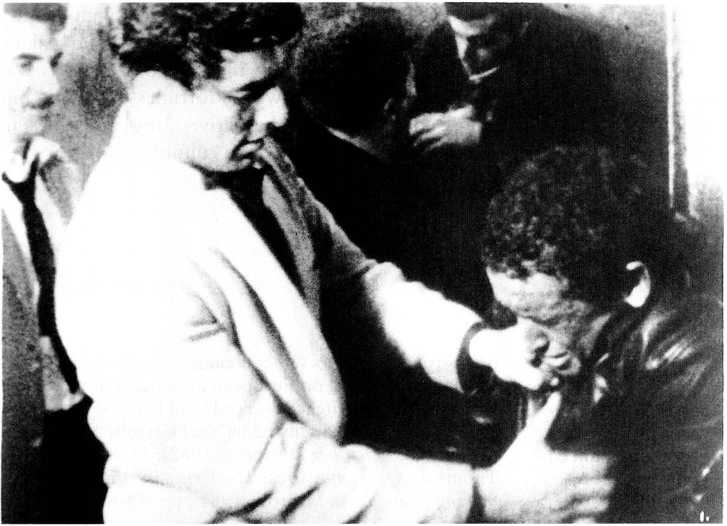The difficulties and recovery of the Majors were bound up with the fate of independent production in the United States during this period. The 1948 Paramount decision and the rise of the teenage market gave independent companies like Allied Artists and American International Pictures (AlP) an entry into the low-budget market (p. 338).
During the late 1960s, the low-budget independents grew stronger, partly through the relaxing of the Production Code and partly through the decline of the Majors. With the slackening of censorship controls, the 1960s saw growth in erotic exploitation. “Nudies" surfaced from the 16mm stag film world and could be seen in decaying picture palaces in America’s downtown neighborhoods. Eroticism became mixed with gore in Herschell Gordon Lewis’s Blood Feast (1963) and 2000 Maniacs (1964). Russ Meyer began in nudies before discovering his idiosyncratic blend of hammering editing, gruesome violence, and parodically overblown sex scenes (Motorpsycho, 1965; Faster Pussycat, Kill! Kill!, 1966). Meyer blazed the trail for “mainstream” 1970s pornography with films such as Vixen (1968).
The youthpics craze was fed by AIP’s cycle of motorcycle-gang movies and Wild in the Streets (1968). The films of AIP’s main director, Roger Corman, had a strong influence on young directors of the late 1960s, and AIP gave opportunities to Coppola, Scorsese, Bogdanovich, John Milius, De Palma, Robert De Niro, and Jack Nicholson. The low-budget independent film Night of the Living Dead (1968), rejected by AIP as too gory, went on to become a colossal cult hit and launched the career of director George Romero.
During most of the 1970s as well, independent production proved a robust alternative to the Majors. As the studios cut back production, low-budget films helped fill the market. Firms began to specialize in certain genres—martial-arts films, action pictures, erotic pictures (sexploitation). Films aimed at African Americans (blaxploitation) showcased young black performers and, sometimes, black creative personnel like directors Gordon Parks, Sr. (Shaft, 1971) and Michael Schultz (Cooley High, 1975; Car Wash, 1976). In the wake of Night of the Living Dead and The Exorcist, the teenage horror market was tapped with films like Tobe Hooper’s grotesque Texas Chainsaw Massacre (1974) and John Carpenter’s more sober and expensive Halloween. Corman’s new company, New World Pictures, created cycles and trained new directors (Jonathan Demme, John Sayles, James Cameron).
In some venues, the cheaper films could find an audience denied to the glossier studio product. Sunn International discovered, to the Majors’ surprise, that there was still a family audience who could be lured from the television set with wildlife adventures and quasi-religious documentaries. Tom Laughlin, the enterprising director-producer-star of Billy Jack (1971), showed that smalltown viewers would still come to films that mixed sentiment, action, and populist themes. Meanwhile, teenagers and college students began flocking to outrageous movies like John Waters’s Pink Flamingos (1974). Theaters found that midnight movies would attract a young crowd; The Rocky Horror Picture Show (1975) and Eraserhead (1978) became profitable almost solely through such shows.
The Majors responded by absorbing the sensational elements that had given independent films their edge. Big-budget films became more sexually explicit, and for a time Russ Meyer, exploiter of erotica, found himself working for a studio (Beyond the Valley of the Dolls, 1970). The Exorcist traded on blasphemy and visceral disgust to a new degree. Star Wars and Close Encounters incorporated elements of low-budget science fiction (Silent Running, 1971; Dark Star, 1974), while Alien (1979) and other films reflected the new standards of gory violence established by independent directors such as Carpenter and David Cronenberg (Rabid, 1977; The Blood, 1979). ‘‘‘Exploitation’ films were so named because you made a film about something wild with a great deal of action, a little sex, and possibly some sort of strange gimmick,” wrote Corman. “[Later] the majors saw they could have enormous commercial success with big-budget exploitation films.”10
Apart from the mass-market independents, there emerged a more artistically ambitious independent sector. New York sustained an “off-Hollywood” tendency. Shirley Clarke, known for her dance and experimental shorts, adapted the play The Connection (1962) and made the semidocumentary The Cool World (1963; 22.32). Jonas and Adolfas Mekas modeled Guns of the Trees (1961) and Hallelujah the Hills (1963) on the experiments of European new waves.
The most famous member of this off-Hollywood group was John Cassavetes. A New York actor committed to Method acting, Cassavetes made a career on the stage and in films and television. He scraped up donations to direct Shadows (1961). “The film you have just seen was an improvisation”: this curt closing title announced Cassavetes’s key aesthetic decision. The story,

22.32 Shirley Clarke directing The Cool World.

22.33 The roughly shot beating of Ben {Shadows).
About two black brothers and their sister in the New York jazz and party scene, was unscripted; the actors shared creative choices about dialogue and delivery with the director. Although shooting in a semidocumentary style, with a grimy, grainy look (22.33), Cassavetes also relied on deep-focus compositions and poetic interludes familiar from contemporary Hollywood cinema. Shadows won festival prizes and led Cassavetes to undertake
A pair of ill-fated Hollywood projects. He returned to independent cinema, financing his films by acting in mainstream pictures, and became an emblematic figure for younger filmmakers.
Basing his aesthetic on a conception of raw realism, Cassavetes created a string of films featuring quasiimprovised performances and casual camerawork. Faces (1968) and Husbands (1970), with their sudden zooms to close-up and their search for revelatory detail, use Direct Cinema techniques to comment on the bleak disappointments and deceptions of middle-class American couples. Characteristically, his counterculture comedy Minnie and Moskowitz (1971) centers on the love affair of a middle-aged hippie and a lonely museum curator. In A Woman under the Influence (1974), Opening Night (1979), and Love Streams (1984), the drama alternates between mundane routines and painful outbursts that push each actor to near-hysterical limits. This spasmodic rhythm, and his focus on the anxieties underlying adult love and work, made Cassavetes’s midlife melodramas seem experimental by 1970s and 1980s Hollywood standards.
The New York scene received a further burst of energy from Joan Micklin Silver’s Hester Street (1975), a drama of Jewish life in late-nineteenth-century New York. Filmed for less than $500,000, it was released nationwide and earned more than $5 million. When it received an Academy Award nomination, the film sparked a new awareness of off-Hollywood filmmaking.
The independent impulse spread to regional filmmakers, who managed to make low-budget features centered on territories seldom brought to the screen. John Waters revealed Baltimore as a campy Peyton Place (Female Trouble, 1975), while Victor Nunez’s Gal Young ’JJn (1979) took place in Florida during the Depression. Another historical drama was John Hanson and Rob Nilsson’s Northern Lights (1979), set in 1915 North Dakota during labor unrest. It won the best first-film award at the Cannes Film Festival.
Slowly, alternative venues were emerging for independent film. In addition to New York’s Anthology Film Archive (founded in 1970), several festivals were established in Los Angeles (known as Filmex, 1971), Telluride, Colorado (1973), and Toronto and Seattle (1975), as well as the U. S. Film Festival (1978), later known as Sundance. At the same time, enterprising filmmakers organized the Independent Feature Project (IFP) as an association of independent film artists, and the IFP established, in 1979, the Independent Feature Film Market as a showcase for finished films and works in progress. The American independent cinema was poised for takeoff.
During the 1960s, the failing studios searched for new corporate identities and business models. After some winnowing, the 1970s set in place patterns that would dominate American film for the rest of the century. A new generation of moguls would partner with a new generation of producer-directors, typified by Lucas and Spielberg, under the auspices of a conglomerate. The studios would concentrate on funding and making must-see movies. Alongside the expanding industry was an independent sector whose fortunes fluctuated but whose commitment to alternative stories and styles increased the variety of U. S. film culture.




 World History
World History









